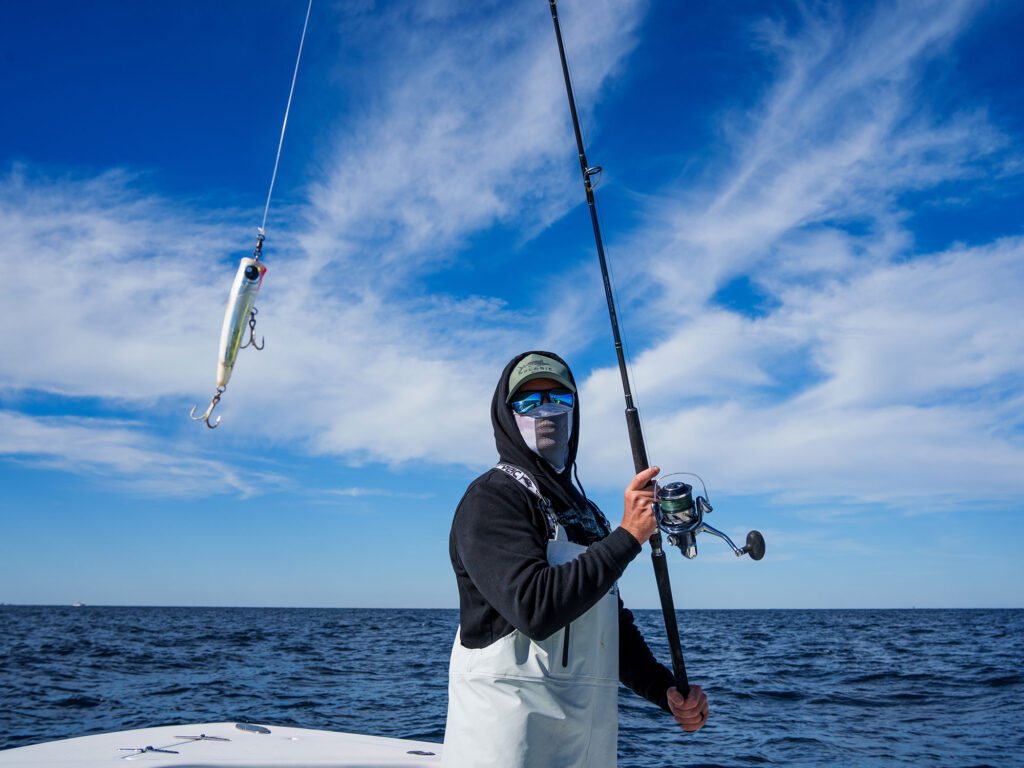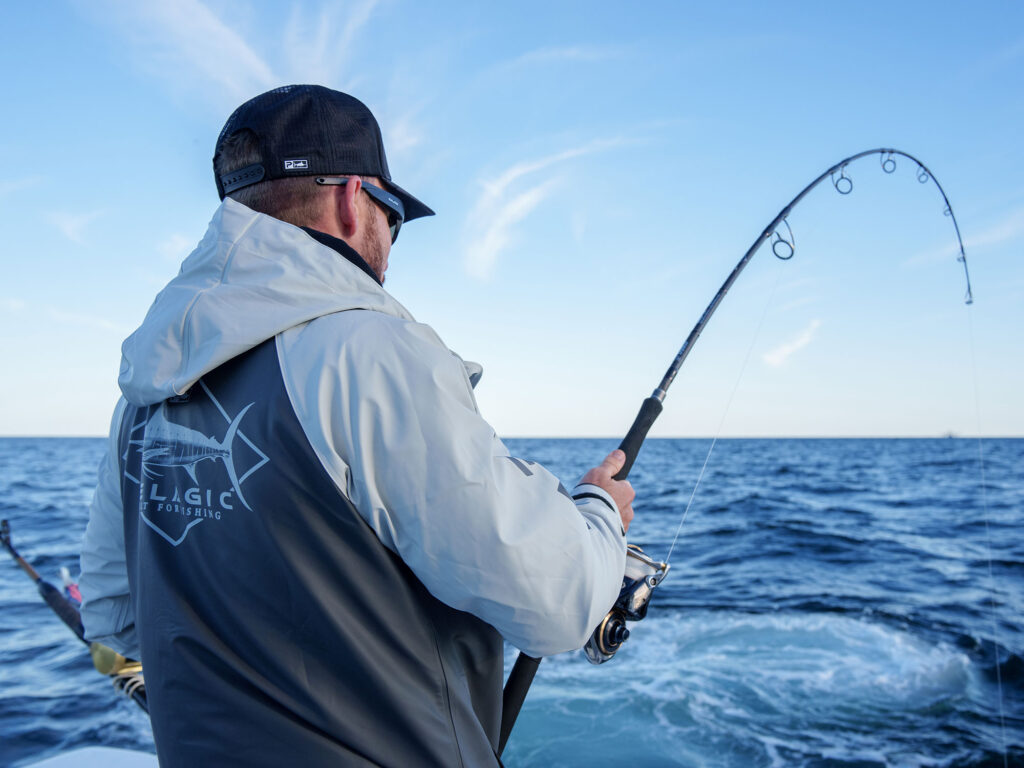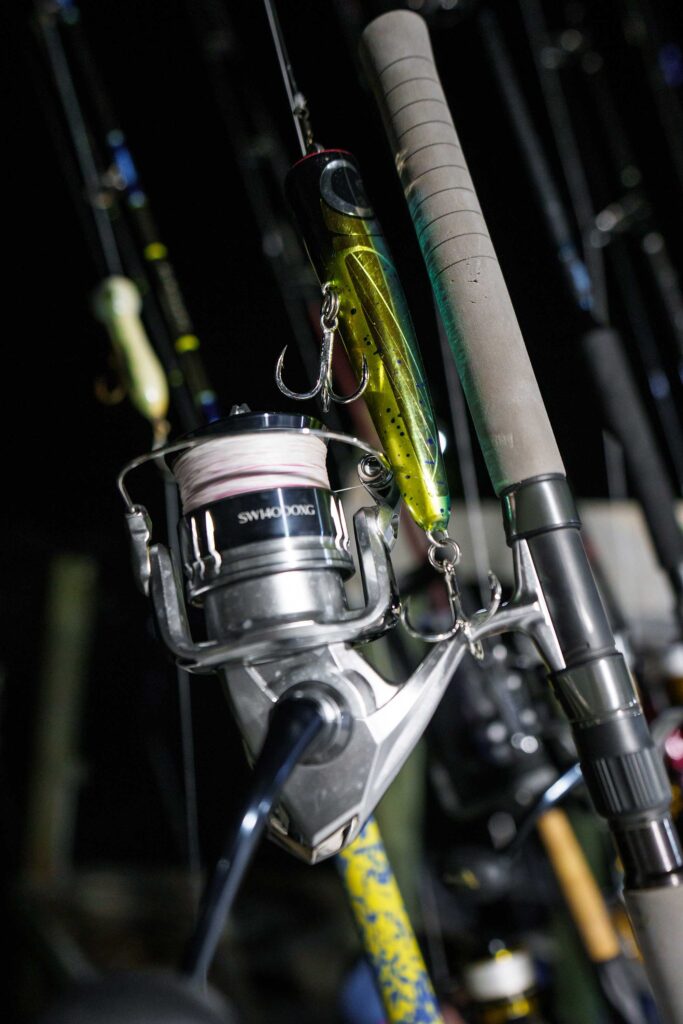“Be careful what you wish for,” my captain chuckled when I expressed my desire to hook a 200-plus-pound yellowfin tuna on popping tackle. While I wasn’t entirely new to this style of fishing, I understood there was still much to learn. Casting a large popper at one of the ocean’s biggest and strongest fish challenges even the most experienced anglers’ skills and tackle. Did I have the will and determination to outlast a monster tuna?
Over the past two years and countless hours on the water, I’ve gained invaluable insights into these fish and the techniques required to reel them in successfully. Landing a 100-to 200-pound fish demands precision. And probably a bit of luck. The distinction between a successful catch and a fish tale often boils down to a single decision gone awry.
When to Pop for Tuna
Selecting the right conditions to cast a popper is the crucial first step. A calm ocean devoid of surface activity is unlikely to yield many bites. However, encountering surface explosions, bait on the surface, or tuna breaching warrants the use of a popper for optimal presentation. Set yourself up for success.
Directing the boat straight toward where the fish are breaking the surface risks spooking them. Hence, making a sufficiently long cast betters your chances of a strike. As the angler, I prefer positioning myself on the bow or atop a casting platform to execute a forceful cast. Typically, more bites occur when the popper is far from the boat. Not only are fish less skittish at greater distances, but the retrieval and action of the lure is much more effective farther out due to line angle. You’re more likely to get bit 100 feet away compared to just 20 feet out.
The Retrieve
I prefer to adjust my popper retrieval technique based on the prevailing conditions. When there’s minimal surface activity or after a blitz has subsided, I favor a pop-and-wait approach. Allowing 3 to 5 seconds between pops gives nearby tuna a chance to locate the lure. If I spot fish feeding directly ahead, I adopt a more aggressive popping style, ensuring the popper has just enough time to resurface between pops. And if I chance upon a bait ball with frenzied tuna, I frantically pop the lure through the blitz. If I don’t hook up immediately, I quickly reel in and re-present the lure. There’s no time to waste when fish are in a frenzy around a bait ball.

The Popper Hookset
My initial instinct upon seeing a strike on my popper is to set the hook immediately, a habit that has plagued me since I started using topwater lures. However, seasoned anglers advise against setting the hook until you feel the fish pulling on the lure, a tactic especially vital in tuna fishing. Tuna can sometimes eat a lure erratically and run straight toward the boat. I refrain from setting the hook until I feel fish weight pulling some drag. Getting the line tight with these unpredictable fish is crucial for success.
Fighting the Fish
“Stay tight to the fish!” That’s what every tuna captain yells to their clients. Even large tuna tend to change directions mid-fight, so keeping the angler ready to reel as fast as possible is crucial. I’ve witnessed numerous instances where an angler’s line goes slack mid-fight, giving the false impression that the fish has escaped, only for it to start ripping drag in another direction. The number one way to increase your landing odds is to remain vigilant and ready to reel quickly if needed. A slack line can lead to a pulled hook.
Fighting a big tuna on spinning tackle is no easy task. Every moment the angler rests, the fish is also resting. Large tuna make anglers earn every inch of line, and on popping tackle, this challenge is even greater. To avoid prolonged battles, I highly recommend passing the rod to another angler if the current one cannot make progress. The less time the fish spends in the water, the lower the risk of a shark encounter.
As the fish nears the boat, prep becomes paramount. I suggest having 2 to 3 gaffs ready for a 100-plus-pound fish and a clear plan delineating each person’s role, from clearing the boat deck to driving and sticking the gaff. It’s crucial to avoid attempting to gaff a big fish when it’s still deep, as errant gaff shots could cause full-grown men to be pulled overboard by massive tuna. If everything goes according to plan, a massive tuna should now take up space on the deck.
Read Next: Using Clear Poppers to Catch Bluefin Tuna

Popping Gear
Pick the right rod, reel, and popper combo for success. Quality gear can be the difference between a tuna on the deck or clean ice coming back home. Here are a few things to look for when making gear choices:
Reel
I prefer using large spinning setups with powerful drag and high gear ratios. I can fish 20 pounds of drag in some situations. Having the ability to keep up with the speed of a tuna is a must. Typically, I recommend 14,000 to 20,000 size spinning reels.
Premium Recommendations:
Economic Recommendations:

Rod
Making those long casts is crucial. For me, I’m picking up a 7-foot, 6-inch or 8-foot rod every time. Popping rods are typically this long and usually have a faster tip to better work a popper.
Recommendations:
Braid and Leader
Not all braids are created equal. I’ve seen too many giant fish lost due to budget braids. I use the thinnest braid with the best strength I can find. On the US market, I’d recommend 50- to 80-pound braids. For international brands, I’d recommend PE 5-8. Four to 5 feet of 80- to 100-pound fluorocarbon leader connects popper to main line.
Recommendations:
- Silk Ocean PE 6 (Diameter: 0.38mm) Breaking strength 97 pounds
- Silk Ocean PE 8 (Diameter: 0.42mm) Breaking strength 109 pounds
Poppers
Poppers can range widely in size, profile, and build quality. As with anything, you get what you pay for. I’ve used plenty over the years, but a few brands stick out to me. I always use BKK replacement treble hooks. Stock hooks on cheaper poppers are not always the highest quality.
Premium Recommendations:
Economic Recommendations:









